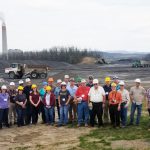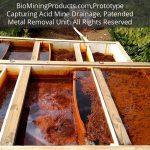#3, Connecting The Dots Between Agriculture and Acid Mine Drainage (AMD)
Why knowing Agriculture is important to do AMD, and vice versa
Hi All! There are many water pollution problems in the world and Agriculture and Acid Mine Drainage are two of the heavies. Reading this article it may help you think differently about two common pollution problems that have a common solution. Most of the water problems we deal with are really imbalances of one substance or another, usually industrial in nature. If you combine one waste stream with another you gain opportunities to clean both more efficiently. Read on to learn more….
Before we begin however, a couple of “sciency” terms first. It gets deep from here on out, haha. (Note, these are my functional definitions, not Webster’s or a textbook, see the links for deeper reading).
Colins Ultra Official Sciency Definitions:
- Biofilm: a living mass of cells (parts of cells, hormones, enzymes…) and the film (EPS or extra-polysaccharidal) the cells excrete and live in. EPS increases environmental survivability for the species involved and allows for intracellular chemical communication.
- Bioremediation: directly promoting biofilm growth and diversity to cycle pollutants or matter and convert them to useful, or non-toxic, forms at rates that are useful for work, (in the classical sense of getting shit done).
- Biodiversity: the sum of all the different species, and their relative population sizes, in an environment or ecological niche.
- Metabolic pathway: how an organism gets its energy and carbon for life. Knowing the metabolic pathways in an environment can tell you a lot about how to make that environment do more “work” for you in terms of bioremediation.
- BioGeoChemistry: the simultaneous study of biology, geology, and chemistry, all at once, and how they change and effect planets, environments, and you and me.
- Natural Attenuation: the sum total of biogeochemical interactions in an open environment that removes “polluting” impacts without the direct aid of human interaction.
- Self Selection: like natural attenuation, pollutant loads are removed in an environment, different metabolic pathways are presented with increased reproductive advantages, and a population shift can occur. This is accomplished without direct human interaction.
Alright, enough of that! What the hell does that all mean and what does it have to do with Agriculture and Acid Mine Drainage!?
Get Ready To Take Some Notes…ha!
Without direct human influence, biofilm aids in the attenuation of a pollution source through endemic (native) microbes. Sometimes in little ways, sometimes in ways where the biofilm is responsible for the majority of the bioremediation.
The pollutant provides a source of energy and/or carbon, or some form of abiotic competitive advantage.
When provided more carbon, energy, nutrients one or many populations will increase and speed natural attenuation. This removes the pollutant more rapidly than geochemical reactions alone allow for, doing more bioremediation work.
Phew, got through it. Sounds pretty simple, but it took me years to wrap my brain around it fully.
So, Agriculture and Acid Mine Drainage… An AMD seep can last for centuries. We can’t stop farming.
When a heavily impacted agricultural water source is mixed with a classic mine drainage seep (iron, aluminum, manganese) natural attenuation, unaided by direct human influence, will sort and attenuate those various pollutants. The “sorting” is based on the pollutants biogeochemical properties and the water is cleaned.
Waiting for natural attenuation to do its’ thing also wipes the river out for miles down stream.
“Work” is accomplished but the impact is spread out over a huge area. Biofilm requires each of the mentioned elements to survive and thrive.
Without going deeper, agricultural nutrients in over abundance (hyper-eutrophication) outcompete other microbes until the vast majority of the nutrients are sequestered in the environment and are no longer readily available for metabolism. Algae growth, death, and settling to the river bottom is a prime example. (Think Chesapeake Bay). If there is no AMD in this impacted water, the water would now be clean. Devoid of higher order organisms sure, but clean and ready for a “fresh” start.
If there Is acid mine drainage present, the AMD pollutant’s concentrations self select for specific (metabolic) pathways. The “AMD” biofilm is no longer outcompeted by hyper-eutrophic conditions and take over, cleaning the water by sequestering the metals in the wetland.
Is this a gross over-simplification? You bet.
The science, or art, of directed bioremediation comes from knowing how nutrients and metals beneficially or negatively impact each other in Agriculture and Acid Mine Drainage. Got too much Al in your water? Add phosphorous and precipitate clays instead of adjusting the pH (an abiotic measure of acid and base) of the water or adding flocculant/polymer.
Need to lock down more phosphorous or potassium in your nutrient sink wetland? Add dissolved manganese, organic carbon, and endemic fungi will precipitate manganese oxides. This creates more highly catalytic surface area, then more biofilm, increasing bio-sequestration of ‘nutes. Add sunlight or artificial light to increase the rate further. I’ll cover more pathways later.
Nutrients can be manipulated to increase AMD system efficiency but are not sampled or misunderstood.
No one wants to do more when it costs extra and they don’t know the value of the added data. Totally understand. But knowing the metabolic pathways which attenuate certain pollutants reduces system size and cost. That saves way more money for the cost of two extra sample parameters (N and P).
Now, reverse it.
Normally, agriculture and acid mine drainage are totally open loop. Water and sunlight come from the sky and leave in rivers and radiated energy. In semi closed loop and closed loop agricultural systems, recycled water and nutrients, when not sequestered within our PermaCycler begins to chronically (ha) impact your crops. Examples of semi-closed loop systems are medical cannabis grows, greenhouses, or Mars.
Or, if you don’t realize you have a metal lock issue occurring in your grow leading to a lack of needed metallic nutrients, you have another problem. It all stems from knowing the removal rates of metals related to AMD. And back, and forth.
For Agriculture and Acid Mine Drainage, I take my own advice now. When I do AMD sampling, I pull Nitrate and Phosphate and when I do Ag I pull iron, manganese, and Al.
I already went over my two page limit, and its 2:41AM, so I’m signing off for now.
If you know anyone who may be able to benefit from this knowledge, or one of our bioremediation solutions, please share this article, or reach out and let us know.





